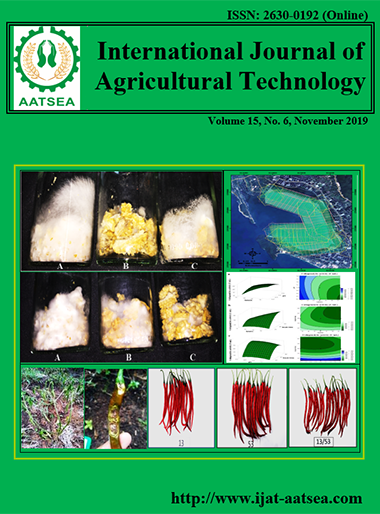Market opportunities for Thai beef cattle exports to Yunnan province, China
Main Article Content
Abstract
The study described beef cattle production, demand, consumption, and prices in ASEAN and China. It presented the internal and external factors of market opportunities for Thai beef cattle exports to China. The Thai domestic fresh beef market is divided into local, middle, and premium markets. There are rised in expectation about constant growth in premium markets, and the consumers are paid a premium for high-quality beef products. In 2015, Thailand and China showed lower population of beef cattle compared with demand. However, China kept the highest market prices in both local and modern markets: 330–420 and 500–560 baht/kg, respectively. From 2011 to 2015, beef consumption in China is increased by approximately 12 percent (808 metric tons). Similarly, live beef cattle imports in China is increased by 35,097 head, which 26 percent increased. In the same period, Thailand showed a dramatic rise in exports by 87,602 head, which 68 percent increased. The rapid increasing in beef imports in China showed that Chinese domestic beef consumption is accelerated and consumer demand for beef continues to grow and great opportunity for the Thai beef cattle export business exists. Thailand’s efficient production system matches the strong consumer demand for a premium market, especially for a Chinese health-conscious market. By analyzing all the factors from the SWOT matrix, the results revealed that IFE was 2.534, EFE was 2.359, and the total weight scores was 4.893, which indicated a significant opportunity for Thai beef cattle exports by minimizing weaknesses.
Article Details

This work is licensed under a Creative Commons Attribution-NonCommercial-NoDerivatives 4.0 International License.
References
Achmad, M., Hartoyo, Arifin, B.and Didu, S. M. (2013). Model policy design for beef cattle development in South Sulawesi. Paper presented at the 1st Annual International Interdisciplinary Conference, Azores, Portugal.
Angkuraseranee, T., Somboonsuk, B., Sukhabot, S. and Nimsai, S. (2017a). Potential and opportunity for beef cattle production in Thailand. Agricultural science journal, 48:841-849.
Angkuraseranee, T., Somboonsuk, B., Sukhabot, S. and Nimsai, S. (2017b). The supply chain and logistics system of the beef trade system between the Union of Myanmar and Thailand for exports to the People's Republic of China, Yunnan. Agricultural science journal, 48:850-858.
Armstrong, M. (2006). Human management resource, 10th ed. Kogan page Limited, London, United Kingdom, pp.957.
Biernackai, P. and Walnorf, D. (1981). Snowball sampling problem and techniques of chain referral sampling. Sociological methods & research, 10:141-163.
Boyce, C. and Naele, P. (2006). Conducting in depth interviews: A guide for designing and conducting in depth interviews for evaluation input. Pathfinder international, Watertown, MA, USA. pp. 16 p.
David, F. R. (2009). Strategic management: Concepts. 12th ed. Translation by DonoSunardi. Jakarta: SalembaEmpat.
Department of International Trade Promotion (2015). Export import summary report of Thailand classified by tariff. Retrieved from http://www.ditp.go.th/main.php?filename=statistics.
Department of Livestock (2015). Number of livestock inventory in Thailand. Retrieved from http://ict.dld.go.th/th2/index.php/th/report/13-statistic.
Food and Agriculture Organization of the United Nations (FAO) (2016). FAOSTAT. Retrieved from http://www.fao.org/statistics/en/.
Global Trade Atlas (2016). International import and export commodity trade data. Retrieved from https://www.ihs.com/products/maritime-global-trade-atlas.html.
Hocquette, J. F., Ellies-Oury, M. P., Lherm, M., Pineau, C., Deblitz, C. and Farmer, L. (2018). Current situation and future prospects for beef production in Europe: A review. Asian-Australasian journal of animal sciences, 31:1017-1035.
Li, X. Z, Chang, G. Y. and Lin, S. Z. (2018). Current situation and future prospects for beef production in China: A review. Asian-Australasian journal of animal sciences, 31:984-991.
Sarma, P. K. and Raha, S. K. (2015). Strategies of beef cattle development enterprise in selected areas of Bangladesh. Advances in Economics and Business, 3:124-132.
SAS (2013). SAS Institute SAS/SAT 9.1 User’s guide. SAS Inst., Cary, NC, USA.
Suryana, Taheri, S. N. and Mighani, A. M. (2009). Model and strategy of agribusiness research cooperation on beef cattle in globalization period. Retrieved from http://www. ukessays. Com / essays /business/swot-analysis.php.
Trading Economics (2017). Forecasts. Retrieved from https://tradingeconomics.com/.
United States Department of Agriculture (2016). Washington, D.C., USA: United States Department of Agriculture Foreign Agricultural Service. Retrieved from https://www.fas.usda.gov/.


